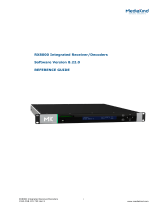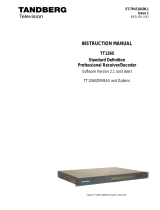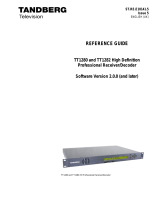Page is loading ...

FMUSER INTERNATIONAL GROUP INC.
FUTV406X Series HD IRD with Demux
option and BISS
User’s manual
V 5.2
FMUSER International Group Inc

FMUSER INTERNATIONAL GROUP INC.
DIRECTORY
Chapter 1 Product Outline................................................................................3
1.1 Outline ................................................................................................................... 3
1.2 Features ................................................................................................................ 3
1.3 Specifications ........................................................................................................ 4
1.4 Principle Chart ...................................................................................................... 6
1.5 Appearance and description ................................................................................. 7
Chapter 2 Installation Guide ............................................................................9
2.1 Acquisition Check ................................................................................................. 9
2.2 Installation Preparation ......................................................................................... 9
2.3 Wire’s Connection ............................................................................................... 11
2.4 Signal Cable Connection .................................................................................... 12
Chapter 3 Operation ........................................................................................17
3.1 Main menu .......................................................................................................... 18
3.2 SETTING menu .................................................................................................. 20
Chapter 4 NMS Setting....................................................................................29
4.1 Installation ........................................................................................................... 29
4.2 Software Operation ............................................................................................. 30
4.3 FUTV406X Series HD IRD NMS Operation ....................................................... 38
Chapter 5 Troubleshooting ............................................................................48
Chapter 6 Packing List....................................................................................49
Chapter 7 Order Information ..........................................................................50

FMUSER INTERNATIONAL GROUP INC.
Chapter 1 Product Outline
1.1 Outline
FUTV406x Series HD IRD can decode TS signals from ASI, tuner (respectively supporting
DVB-S/-S2/-C/ -T & DMB-T & ISDB-T) or IP sources into audio and video signal. With the help of
CAM module, it can package the entire TS stream signals into IP packet (UDP) through network
transmission, therefore users can directly watch programs on the computer. This IRD is featured
with demux option, which enables users to output required programs by selection from input
signals. With BISS With BISS descrambling function, this IRD can be applied in Digital Satellite
News Gathering (DSNG). It supports professional HD-SDI, SD-SDI digital video, YPbPr, HDMI HD
multimedia output, XLR balanced audio, and S/PDIF digital audio and CVBS output, thereby it can
greatly satisfy the professional user’s needs.
1.2 Features
l Adopt powerful processor.
l High reliability and excellent operation stability.
l Support PVR function( exterior storage device)
l It is fully compatible with H.264 (MPEG-4 Part 10) and MPEG-2, in compliance with DVB
standard and support MP@HL and MP@ML.
l Equipped with ASI input, supporting cascade.
l Support 2 ASI,1 CVBS,1 YPbPr, 1 HD/SD-SDI,1 XLR and RCA, 1 S/P DIF audio, 1 HDMI HD
multimedia and IP output, 1 USB output(software updating)
l Compatible for both HD and SD, supporting audio embedding.
l Support output HD 1080I, 720P, SD PAL/NTSC.
l PAL/NTSC identified automatically.
l Two CI Slot PCMCIA interfaces.
l Two independent CIM modules, supports maximum 8 programs decryption in each channel.

FMUSER INTERNATIONAL GROUP INC.
l With demux option, in the input programs users can select one or more required programs to
output in ASI or IP.
l Support BISS “mode 1” and “mode E”
l Support RJ-45 interface, NMS, TCP/IP network protocol.
l Support program memory function in condition of power off.
l Support subtitle, teletext function.
l User friendly operation interface and convenient operation menu system.
l Supports led display and button operation.
l User can edit various data from satellite and repeaters.
l Support 1 ASI input, tuner input (respectively supporting DVB-S/-S2/-C/ -T & DMB-T), IP
input( UDP)
l Support DVB-S / DVB-S2 / DVB-C / DVB-T / DMB-T / ISDB-T demodulation. The demodulation
range shows as follows:
l DVB-S/-S2: 950MHz ~ 2150MHz (standard, also supports 350MHz ~ 1.2GHz),
Symbol Rate: 2 ~ 45MBauds
l DVB-C: 47MHz~860MHz, 16, 32, 64, 128, 256QAM
l DVB-T: 47MHz~860MHz, 6, 7, 8MHz bandwidth
l DMB-T: 47MHz~860MHz, support multi-carrier, single carrier.
l ISDB-T: 170 230Mhz and 470 860Mhz, support multi-carrier, single carrier.
1.3 Specifications
FUTV406X Series HD IRD with Demux option and BISS
DVB-C/-S/-S2/-T RF input Module
Connector: F-type, 75Ω
FUTV4061 DVB-C FUTV4062 DVB-S
Input Frequency Range: 47-860MHz Input Frequency Range: 950-2150MHz
Symbol rate: 0.45-7.0MBauds Symbol rate: 2-45Msps
Input Level: -15-20dBmV Signal Strength: -65- -25dBm
Demodulation Mode: 16/32/64/128/256
QAM
FEC Demodulation: 1/2, 2/3, 3/4, 5/6, 7/8
QPSK

FMUSER INTERNATIONAL GROUP INC.
FUTV4063 DMB-T FUTV4065 DVB-S2
Input Frequency Range: 47-860MHz Input Frequency Range: 950-2150MHz
Bandwidth: 8MHz Input Level: -65- -25dBm
Input Level: -15-20dBm Code Rate: 1/2, 3/5, 2/3, 3/4, 4/5, 5/6, 8/9,
9/10
Constellations: 4 QAM-NR, 4 QAM,
16QAM, 32QAM, 64QAM Symbol ratio: 1-45Msymbols
Input Impedance: 75Ω
Demodulation Mode: QPSK, 8PSK
Frequency Stepping: 500 KHz
FUTV4064 DVB-T FUTV4066 ISDB-T
Input Frequency Range: 47-860MHz Input Frequency Range: 170 230Mhz and
470 860Mhz
Bandwidth: 8MHz (2, 6, 7MHz Optional) Bandwidth: 6MHz ( 6, 8MHz Optional)
Input Level: -87- -20dBm Input Level: 0 -95dBm
Constellations: QPSK, 16QAM, 64QAM Constellations: QPSK, 16QAM, 64QAM
FEC Demodulation: 1/2, 2/3, 3/4, 5/6, 7/8 Code Rate: 1/2, 2/3, 3/4, 5/6, 7/8
DVB-CI module
Descrambling procession Supporting European DVB-CSA
Smart Card interface ISO7816
Interface Card separation PCMCIA
ASI input
BNC connector 1 route input;
2 routes output
Input impedance 75 ohm
Maximum transmitting rate 54Mbps
ASI output
BNC connector 1 route input;
2 routes output
Output impedance 75 ohm
Maximum transmitting rate 54Mbps
Ethernet Connector RJ-45
Interface Type 10/100 Base-T(Customized 1000M)

FMUSER INTERNATIONAL GROUP INC.
1.4 Principle Chart
Protocols TS Over IP : UDP, NMS : UDP
Video output
CVBS×1 (BNC) 576i, 480i
YPbPr×1 (BNC) 1080i;720p @ 50 59.94fps
SDI×1 (BNC) 1080i;720p @ 50 59.94fps
576i;480i
HDMI×1 1080i;720p @ 50 59.94fps
576i;480i
Audio output
Stereo unbalanced audio BNC interface
Stereo balanced audio XLR interface
Digital audio SPDIF (AES/EBU embedded in sdi)
Output stream Demux option applied 49Mbps max
General
Dimensions ( L×W×H) 482mm*360mm*44mm
Approx weight 3.2kg
Power <20W(Max)
Temperature range 0~45 (Operation); -20 ~80
(Storage)

FMUSER INTERNATIONAL GROUP INC.
1.5 Appearance and description
Front Panel Illustration
Rear Panel Illustration
Remarks: The difference between DVB-S/-S2 rear panel and DVB-C/-T
rear panel is the interface location of RF IN and LOOP OUT, while the
other interfaces are the same.

FMUSER INTERNATIONAL GROUP INC.
As follows:
DVB-S/S2 Rear Panel
DVB-C/-T Rear Panel
1 DVB-C/-T RF LOOP OUT interface
2 If the machine is DVB–T/-C, it is RF IN interface; if the machine is
DVB–S/S2, it is RF LOOP OUT interface
3 DVB-S/S2 RF IN interface
4 ASI IN: stream input interface
5 ASI OUT1
6 ASI OUT2
7 HDSDI-OUT: HD/SD digital parallel output interface
8 USB interface
9 HDMI interface
10 SPDIF: digital audio output interface
11 YPbPr: Audio component output interface
12 CVBS: Composite video and audio output interface
13 Audio (L/R channel) output interface
14 10M/100M network indicator((Customized 1000M)
15 Ethernet interface
16 Balance audio output interface
17 Integrated power switch and socket

FMUSER INTERNATIONAL GROUP INC.
Chapter 2 Installation Guide
2.1 Acquisition Check
When user opens the package of the device, it is necessary to check items according to packing
list. Normally it should include the following items:
l FUTV406x HD IRD with Demux option and BISS 1pcs
l User’s Manual 1pcs
l ASI Cable 1pcs
l Power Cord 1pcs
If any item is missing or mismatching with the list above, please contact our company.
2.2 Installation Preparation
When users install device, please follow the below steps. The details of installation will be
described at the rest part of this chapter. Users can also refer rear panel chart during the
installation.
The main content of this chapter including:
l Checking the possible device missing or damage during the transportation
l Preparing relevant environment for installation
l Installing modulator
l Connecting signal cables
l Connecting communication port (if it is necessary)
2.2.1 Device’s Installation Flow Chart Illustrated as following

FMUSER INTERNATIONAL GROUP INC.
2.2.2 Environment Requirement
Item Requirement
Machine Hall Space
When user installs machine frame array in one machine
hall, the distance between 2 rows of machine frames
should be 1.2~1.5m and the distance against wall
should be no less than 0.8m.
Machine Hall Floor
Electric Isolation, Dust Free
Volume resistivity of ground anti-static material:
1X107~1X1010ΩGrounding current limiting resistance:
1M (Floor bearing should be greater than 450Kg/ )
Environment
Temperature
5~40 (sustainable ) 0~45 (short time)
installing air-conditioning is recommended
Relative Humidity 20%~80% sustainable 10%~90% short time
Pressure 86~105KPa
Door & Window Installing rubber strip for sealing door-gaps and dual
level glasses for window
Wall It can be covered with wallpaper, or brightness less
paint.
Fire Protection Fire alarm system and extinguisher
Power
Requiring device power, air-conditioning power and
lighting power are independent to each other. Device
power requires AC power 100-240V 50-60Hz. Please
carefully check before running.

FMUSER INTERNATIONAL GROUP INC.
2.2.3 Grounding Requirement
l All function modules’ good grounding is the basis of reliability and stability of devices. Also,
they are the most important guarantee of lightning arresting and interference rejection.
Therefore, the system must follow this rule.
l Coaxial cable’s outer conductor and isolation layer should keep proper electric conducting
with the metal housing of device.
l Grounding conductor must adopt copper conductor in order to reduce high frequency
impedance, and the grounding wire must be as thick and short as possible.
l Users should make sure the 2 ends of grounding wire well electric conducted and be antirust.
l It is prohibited to use any other device as part of grounding electric circuit
l The area of the conduction between grounding wire and device’s frame should be no less
than 25mm2.
2.2.4 Frame Grounding
All the machine frames should be connected with protective copper strip. The grounding wire
should be as short as possible and avoid circling. The area of the conduction between grounding
wire and grounding strip should be no less than 25mm2.
2.2.5 Device Grounding
Connecting the device’s grounding rod to frame’s grounding pole with copper wire.
2.3 Wire’s Connection
The grounding wire conductive screw is located at the right end of rear panel, and the power
switch, fuse, power supply socket is just beside ,whose order goes like this, power switch is on the
left ,power supply socket is on the right and the fuse is just between them.

FMUSER INTERNATIONAL GROUP INC.
l Connecting Power Cord
User can insert one end into power supply socket, while insert the other end to AC power.
l Connecting Grounding Wire
When the device solely connects to protective ground, it should adopt independent way, say,
share the same ground with other devices. When the device adopts united way, the grounding
resistance should be smaller than 1Ω.
FCaution:
Before connecting power cord to FUTV406x HD IRD with Demux Option and BISS, user
should set the power switch to “OFF”.
2.4 Signal Cable Connection
The signal connections include the connection of input signal cable and the connection of output
signal cable. The details are as follows:
2.4.1 FUTV406x HD IRD with Demux function and BISS Signal Cables
illustration:
l IP input cable illustration:

FMUSER INTERNATIONAL GROUP INC.
l HDMI cable illustration
l XLR interface cable illustration:
l RF In and loop out cable illustration:
l Component output, CVBS output and sound channel output cable
illustration:

FMUSER INTERNATIONAL GROUP INC.
l ASI input and output cable illustration:
2.4.3 FUTV406x HD satellite Receiver Signal Cables connection illustration:
l RF IN and LOOP OUT connection:
Users can find the RF IN and LOOP OUT interface on the device according to the connector mark
described on the rear panel illustration, and then connect the cable. One end is connected to the
RF IN interface of satellite receiver while the other end is connected to the satellite signal source
equipment or LOOP OUT interface of the previous satellite receiver when several satellite
receivers are series connection. As follows:
l ASI IN and ASI OUT connection:
Users can find the ASI IN and ASI OUT interface on the device according to the connector mark
described on the rear panel illustration, and then connect the cable. One end is connected to ASI
IN interface of the HD IRD, the other end is connected to any device that has ASI output, while
when connected ASI OUT interface, the other end of the wire is generally connected to encoder
and multiplexer. As follows:

FMUSER INTERNATIONAL GROUP INC.
l Component Output, CVBS Output and Sound Channel output illustration:
Users can find the YPbPr, CVBS and Left/Right sound channel interface on the device
according to the connector mark described on the rear panel illustration, and then connect the
cable. The other end of the wire is connected to encoders.
l HDMI Output illustration:
Users can find the HDMI interface on the device according to the connector mark described
on the rear panel illustration, and then connect the wire. One end of the wire is connected to
the HDMI output interface of the HD IRD, while the other end of the wire is connected to
encoder or other equipment. As follows:

FMUSER INTERNATIONAL GROUP INC.
l IP Output illustration:
Users can find the IP OUTPUT interface on the device according to the connector mark
described on the rear panel illustration, and then connect the wire. One end of the wire is
connected to the IP output interface of the HD IRD, the other end of the wire is connected to
devices with IP INPUT. As follows:
l XLR Output illustration:
Users can find the XLR interface on the device according to the connector mark described on the
rear panel illustration, and then connect the wire. One end of the wire is connected to the XLR
output interface of the HD IRD, the other end of the wire is connected to IP encoder. As follows:

FMUSER INTERNATIONAL GROUP INC.
Chapter 3 Operation
The front plane of FUTV406X series HD IRD with Demux Option and BISS is the user-operating
interface and the equipment can be conveniently operated and used according to the signal
information of the TV display; the simple using method for the machine is as follows:
Keyboard Function Description:
MENU: Canceling presently entered value, resuming previous setting; Return to
previous menu.
ENTER: Activating the parameters which need modifications, or confirming the change after
modification.
LEFT/RIGHT: To choose and set the parameters.
UP/DOWN: Modifying activated parameter or paging up/down when parameter is inactivated.
Attention:
l The ASI input takes precedence if tuner input and ASI input exist at the
same time.
l The device front panel can operate ASI and tuner, while the IP input can
only be controlled by NMS
l In condition of tuner input, users have to search programs by inputting
frequency parameters which is in accord with satellite frequency.

FMUSER INTERNATIONAL GROUP INC.
3.1 Main menu
After turning on the device and displayer, user can press MENU to enter the main menu. As
follows:
The main menu comprises 4 parts: LIVE TV, EPG, PVR, and SETTING. As follows:
l Live TV menu
This menu is used to display programs that the device is receiving at the moment. User can
press ENTER to find the next sub-menu TV LIST to check the programs received. As follows:

FMUSER INTERNATIONAL GROUP INC.
l EPG menu
This menu is used to display the electronic program guide. By pressing ENTER key users can
go to the next sub-menu to check the electronic program guide information. As follows:
l PVR menu
This menu is applied to record programs when the USB inserted. If no USB inserted, after
pressing ENTER it will display the interface as follows:

FMUSER INTERNATIONAL GROUP INC.
l SETTING menu
This is the most important menu consisting of five parts: Installation, Program Edit, System
Setup, User Preference, and CI Multi Programs Descramble.
3.2 SETTING menu
After users press MENU to enter the main menu of the system, it displays as follows:
/














